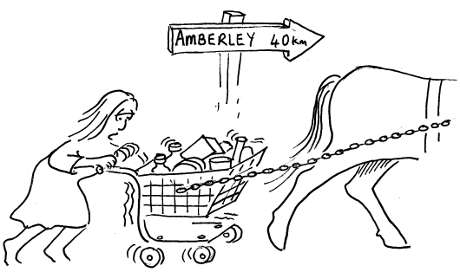The reversal of the economic engine
Economic growth is underpinned by increasing expenditure of energy. All energy comes directly or indirectly from the sun. As there is only a fixed and finite amount of solar energy reaching the earth each year society must draw down the stockpiled reserves of solar energy stored in the form of wood, coal, gas and oil if we are to increase economic activity. Society is exploiting these reserves faster than they are being replenished.
While there is easy and financially viable access to large volumes of energy dense materials the system can increase extraction and consumption of these energy sources, translating into increases in the production and distribution of goods and services. This growth trend allows the financial system to operate under the current modal of interest bearing debt. This is the process by which banks create money (credit) which must be paid back along with any interest accrued.
Money, or credit, represents potential future goods and services which represents energy. In an environment where the population is growing (fed by fossil fuel farmed calories) and there is a strong certainty that the amount of available energy is increasing, the system can continue to issue promises for future work (energy consumption). Under these circumstances businesses and individuals can approach the banks, present their case and borrow money with the confident expectation that economic growth will enable them to pay back the principal plus the interest. This assumption, funded on historic trends and wishful thinking, allows for the execution of important projects requiring substantial capital. For example, Large construction projects, importation of exotic goods etc.

Picture: Neville SinclairOnce the point of peak extraction is passed and each year sees progressively less energy and money available for carrying out work and fulfilling the debt obligation it no longer makes economical business sense to borrow money at interest. Since the amount of money in the system must be similar to the amount of energy it represents then the money supply must diminish (through debt default) or loose its value. Either way debts will be harder to pay down therefore more risky to take on.
If financial institutions and investment schemes are unable to generate profits through the interest mechanism they will look for other ways. It seems to make sense they would seek to control access to essential commodities and collect rents, subscriptions and other tariffs. Areas such as food, water, housing, health care and security come to mind.
Populations will diminish as the energy cost of feeding excessive numbers of people can not be met. Ever higher portion of income will be spent on food and energy, leaving less for servicing debt, paying taxes and discretionary spending, shrinking markets and reinforcing the downward economic trends.
Not all forms of energy are created equal, even if they can supply the equivalent watts. Wind power is a poor replacement for oil since oil can be turned into so many useful products, transports and stores easily. If it were possible to install new energy systems which harvested incoming solar energy at a rate faster than the decline of conventional energy sources we would still be unable to achieve the standard of living many of us are accustomed to.

